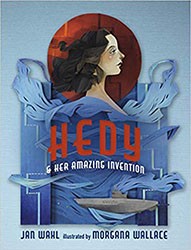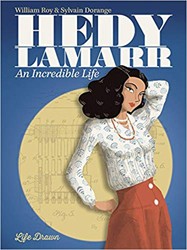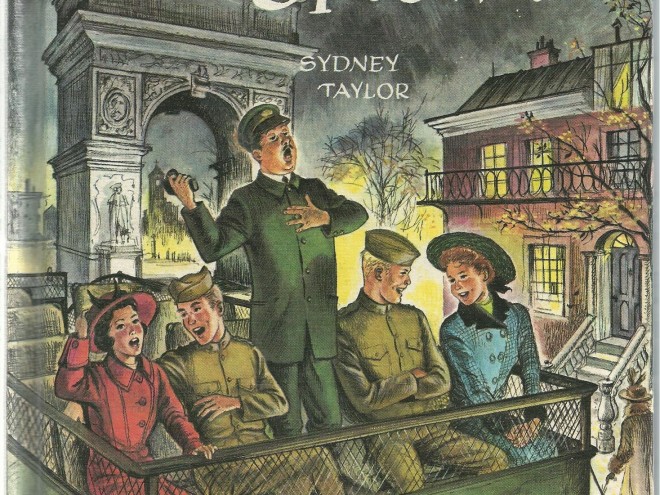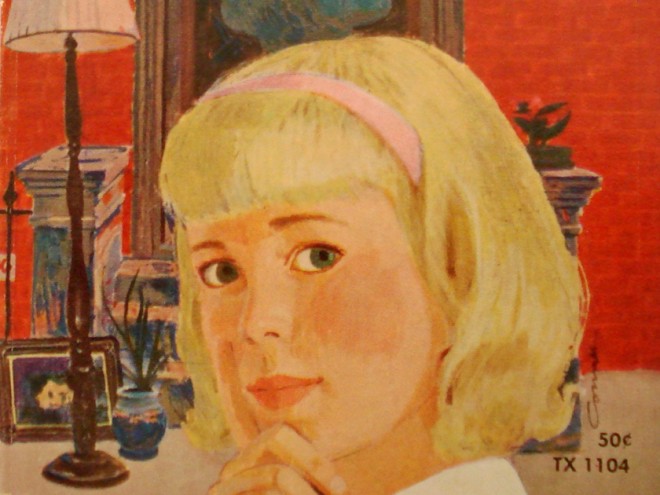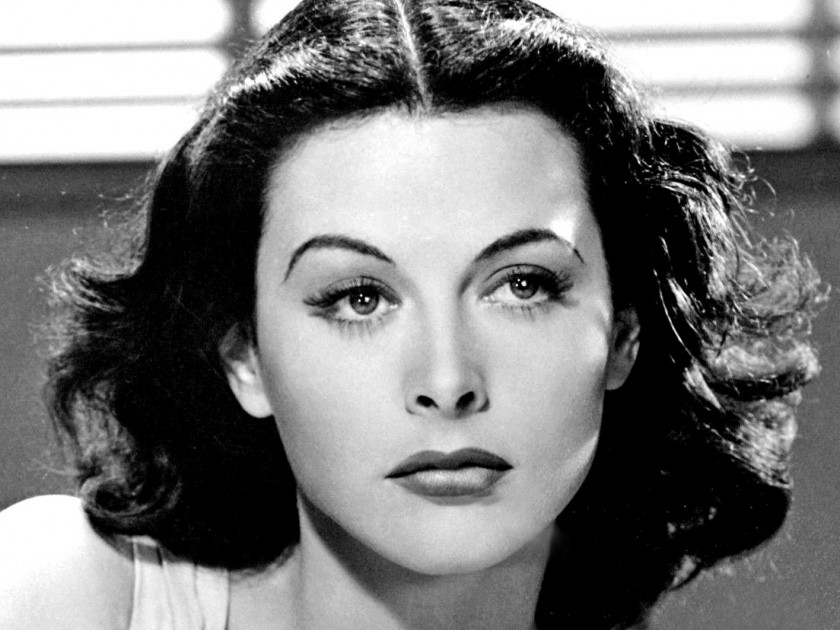
Publicity photo of Hedy Lamarr for film Comrade X, MGM/ Clarence Bull
Who do we decide to showcase in children’s literature and what do we highlight about them? While the pantheon of female role models was once limited to a select few, a much greater range of inspiring women now take the stage in children’s books; whether artists, activists, or political leaders, the question of how to approach their cultural and ethnic background always arises, even if it is not the central focus of a woman’s story. The question of how — or even if — to discuss Jewish identity becomes a complex one. Actress and innovator Hedy Lamarr, born Hedwig Eva Maria Kiesler (1914−2000), appeared as the subject of two picture book biographies in 2019, Hedy and Her Amazing Invention, by Jan Wahl, illustrated by Morgana Wallace, and Hedy Lamarr’s Double Life, by Laurie Wallmark and Katy Wu. She also made a cameo appearance in Vashti Harrison’s Little Dreamers: Visionary Women Around the World. (No doubt, Israeli actress Gal Gadot’s upcoming miniseries about the actress will only increase interest in her life.) Within these recent books, Lamarr’s Jewish identity seems as cryptic as the torpedo guidance system which she invented — in which messages from a ship would be sent with varying frequencies, eluding interpretation by the enemy. Was Lamarr’s successful career mixing glamour with intellect rooted in the vulnerability of her Jewish past? Authors are divided on this question. Wallmark avoids placing any significance on her heroine’s coming of age in a middle-class Jewish family in Vienna right as the Nazis were taking power, while Wahl does mention the aspiring actress’s rebellion against a conventional — and Jewish — life. Harrison is the only one of the authors to specifically claim that Lamarr’s choice of secrecy about her background was a deliberate and protective one. Each of these three books for children raises questions about the presentation of Jewish identity.
Few children today would be able to identify Lamarr from a lineup. Lamarr’s admission into the world of children’s biographies is undoubtedly due to her image as a STEM heroine, one whose endeavors in the world of technology refute the outdated idea that brains and beauty cannot coexist in one woman. The genre of children’s biographies, with their short length and young audience, leads to the omission of many aspects of their subject’s lives; Lamarr’s Jewishness may seem less relevant than her ability to defy convention as a stunning geek. She was not religiously observant, nor were her parents; her mother had converted to Catholicism to better assimilate into Austrian society. Unlike other prominent Jewish women of the time — Emma Lazarus, Henrietta Szold, or Golda Meir — her life was not dedicated to helping Jews. Lamarr seemed to flee from her past when she crossed the Atlantic Ocean, evoking a sense of the mutability and danger of Jewish identity.
Lamarr seemed to flee from her past when she crossed the Atlantic Ocean, evoking a sense of the mutability and danger of Jewish identity.
The dramatic cover and endpapers of Wallmark’s Hedy Lamarr’s Double Life promise to resolve the paradox of stereotypically feminine and masculine qualities in one person. The book’s title is posted on a movie marquee surrounded by lights, followed by the subtitle “HOLLYWOOD Legend and Brilliant INVENTOR.” Wu’s illustration superimposes Lamarr’s divided face: one half sporting a dangling earring and a dressy collar, the other a pencil and pen protruding from a simple shirt pocket with one side of the face bordered by movie reels, the other by inventor’s sketches. “Who was the real Hedy Lamarr,” the book asks, and can a person only have one identity, which renders false other dimensions which seem to compromise this core? In fact, this was the dilemma of many Jews in Central Europe, who struggled to balance their Jewish identity with participation in societies that viewed them with prejudice. Subsequent pages alternate between descriptions and images of Lamarr as a magnetic screen presence and as a hard-working inventor, while ignoring the other duality of Lamarr as a Jewish refugee from Europe and an icon of American beauty. Adult readers familiar with Lamarr’s biography will note missed opportunities to explore this tension with children.
Wallmark situates Lamarr’s childhood in a specific time and place, one where dramatic changes would soon surface, altering the course of her life. The author writes, “Even as a child in Austria in the early 1920s, Lamarr’s curious mind wanted to know how things worked.” Wu depicts Lamarr walking with her father through interwar Vienna, yet the significance of their environment is strangely absent: “During their walks around their hometown of Vienna, Austria, they exchanged ideas about everything and anything.” Presumably, as Lamarr grew into a young woman, these talks would have included the rise of fascism and antisemitism. Both author and illustrator focus on Lamarr’s love of both acting and engineering, leaving aside the forces which would drive her from a world about to be engulfed in tragedy. The transition is abrupt; after Lamarr is “discovered” on stage by Jewish film producer Louis B. Mayer, “Hedy left her family behind in Europe and settled in America.” Readers might assume that nothing more than personal ambition led to the actress’s decision to leave. Wallmark also omits any reference to Lamarr’s need to escape her unhappy marriage to Fritz Mandl, a wealthy and controlling armaments producer for the Nazis. Mandl was also of partly Jewish heritage. Lamarr’s marriage to him also reflects their mutual membership in Vienna’s affluent and assimilated Jewish community.
Both author and illustrator focus on Lamarr’s love of both acting and engineering, leaving aside the forces which would drive her from a world about to be engulfed in tragedy.
History is not absent from Hedy Lamarr’s Double Life. No sooner has Lamarr arrived in Hollywood than “World War II was raging, and everyone was afraid.” The promising young actress becomes consumed with fighting the Nazis, and her fortuitous meeting with composer George Antheil gives them both the chance to develop the system of frequency hopping for torpedo guidance systems. They would earn a patent for it, although the invention was not deemed practical for use until after the War. Lamarr’s persistence in her goal of helping to defeat Hitler is never once linked to her Jewish identity, even if that motivation was peripheral to her patriotism and intellectual curiosity. Wallmark and Wu also devote two pages to Lamarr’s work promoting war bonds and volunteering to entertain soldiers at the famed Hollywood Canteen. She was one of many Hollywood stars who devoted energy to these projects, but she must have been aware that, had she not found a haven in the United States, she may not have survived to play this role. In the end, this exciting and graphically innovative book for young readers assigns a dual identity to Lamarr, that of actress-inventor. Lamarr’s Jewish past remains encoded in confusing signals.
In contrast, Wahl’s illustrated chapter book attempts to resolve the issue of Lamarr’s background within the simplified story of her life for young readers. There is limited detail about how Lamarr’s home of Vienna was infused with Jewish cultural influences, but Wahl briefly mentions how her interest in acting was perceived: “Her parents worried. Such a life for a well-brought-up Jewish girl!” Lamarr’s marriage to Mandl is also described as a prison, and Wahl alludes to discussions of war and weapons which dominated parties in their home. Readers learn that her life in America was plagued by anxiety: “Hedy worried about her mother…Hedy lay in bed at night imagining the horror of it.” Wahl discusses how Lamarr was able to secure her mother’s release and bring her to America. In Wahl’s biography, the subject has a past which actively appears to inform her present actions and motives, making her pursuit of a secure communication system arguably more than the product of intellectual exploration.
In Wahl’s biography, the subject has a past which actively appears to inform her present actions and motives, making her pursuit of a secure communication system arguably more than the product of intellectual exploration.
In Vashti Harrison’s biographies children learn about exemplary individuals through short summaries of their lives accompanied by appealing illustrations. Lamarr is one of more than thirty women included in Little Dreamers: Visionary Women Around the World. The company she keeps in this anthology is a clue to Harrison’s ecumenical embrace of female genius, including artists, scientists, and musicians. Lamarr clearly symbolizes a woman whose genius is not confined to one sphere. But Harrison is also clear that prejudice might have stood in Lamarr’s way as she pursued a career in two different fields.
Lamarr’s section opens with references to her fascination with mechanical processes and her attraction to acting, and also notes the significance of her relationship with Mandl. Unlike Wallmark, who avoids Lamarr’s Jewishness, or Wahl, who is much more allusive about its significance, Harrison describes Lamarr as a victim of hatred who managed to liberate herself and achieve her goals. She “escaped both the Nazis and her husband,” and was “careful to keep her Jewish heritage a secret,” as she reinvented herself in America as “the glamorous Hedy Lamarr.” Harrison equates Mandl’s domineering character with his support for Nazism, and makes Lamarr’s emigration to America an explicit deliverance from these persecutions. Even bolder is Harrison’s inference that Lamarr’s Hollywood career was contingent on hiding her Jewish identity. Drawing attention to that identity would have been unusual; Jewish actors from Lauren Bacall to Edward G. Robinson routinely anglicized their names. At the same time that Harrison emphasizes pushing against boundaries, she reminds readers that prejudice against Jews in America was one limit the actress chose not to question.
Lamarr lived a double life, as each of the books discussed here emphasizes. Her legacy has benefited from the recent push to equalize the gender disparity in STEM fields. Lamarr’s combination of scientific and cinematic success has overshadowed a more hidden one; glamorous and brainy Hedy Lamarr was once Hedy Kiesler, an ambitious young Jewish woman forced by circumstance to abandon her home in Europe and start over in America as a refugee. Regardless of her decision to relegate that fact to her past, it was the foundation of her work in the US. At one time, Lamarr aspired to produce and star in a movie about Queen Esther, the beautiful and astute Jewish woman who went undercover to save her people. The project never came to fruition and Lamarr’s work on the World War II home front — unlike the Persian queen’s strategies — was aimed at saving the free world more than the Jewish people. Still, the parallel is useful to examine how and why we view Lamarr’s contributions and identity as we do. Ambivalence about an identity which was often fraught with risk should be part of the discussion of what it means to be Jewish. Hedy Lamarr’s life of determination and achievement is a starting point for approaching this difficult truth.
Emily Schneider writes about literature, feminism, and culture for Tablet, The Forward, The Horn Book, and other publications, and writes about children’s books on her blog. She has a Ph.D. in Romance Languages and Literatures.
